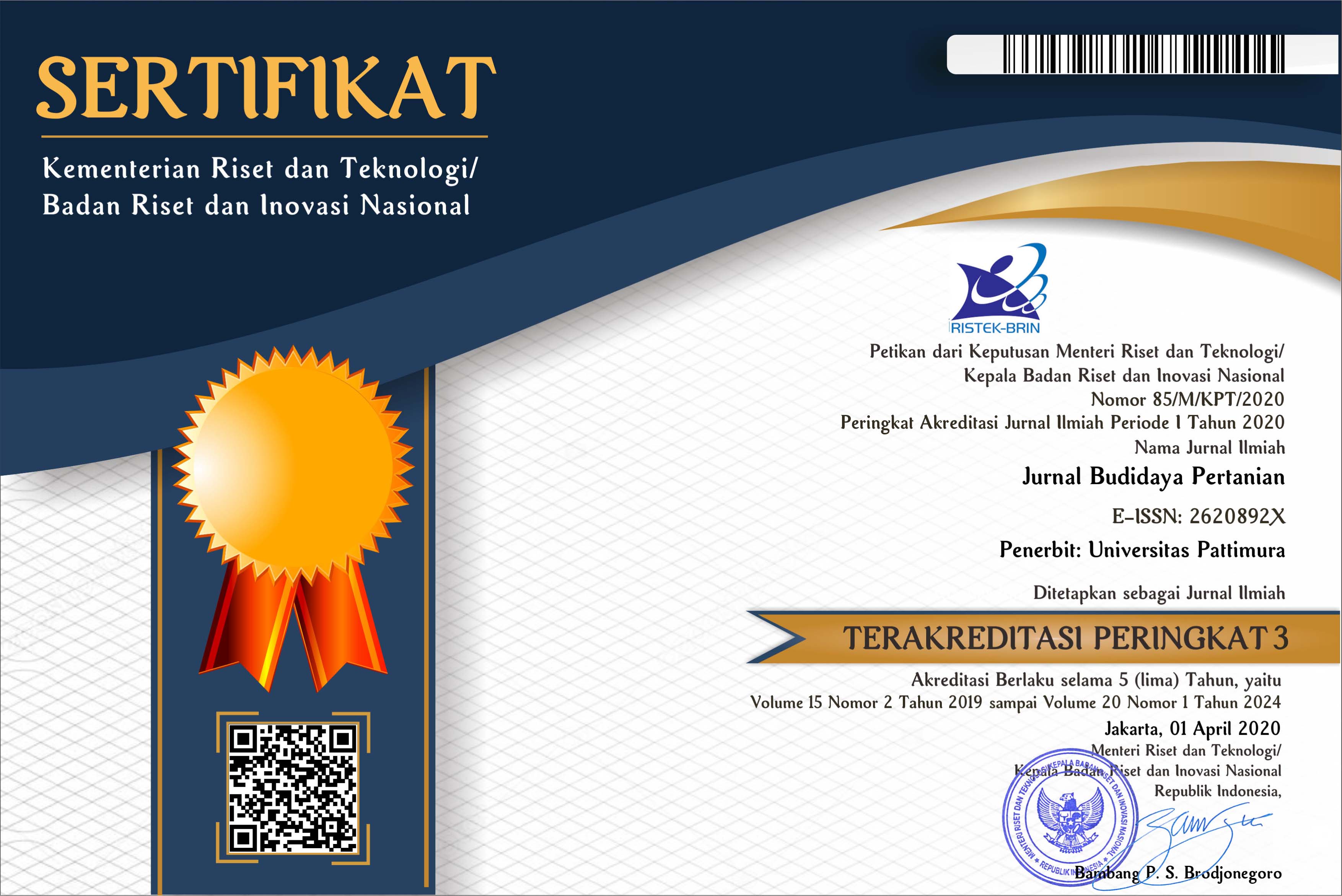Karakterisasi Morfologi dan Analisis Klaster Aksesi Kopi (Coffea sp.) Asal Seram Bagian Selatan, Indonesia
Morphological Characterization and Cluster Analysis of Coffee (Coffea sp.) Accessions From Southern Seram, Indonesia
Abstract
Sebagai wilayah budidaya kopi, bagian selatan Pulau Seram memiliki banyak jenis kopi yang ditanam oleh petani yang menanam kopi di sana. Penelitian ini bertujuan untuk mengases keragaman morfologi aksesi kopi (Coffea sp.) yang dibudidayakan di wilayah Seram Bagian Selatan, khususnya di Kecamatan Tehoru dan Amahai, serta mengelompokkan aksesi tersebut berdasarkan kesamaan morfologi menggunakan analisis klaster hierarkis. Sebanyak 45 aksesi diamati, terdiri atas 16 aksesi Arabika dan 29 aksesi Robusta. Karakter morfologi yang dianalisis meliputi struktur batang, daun, bunga, dan buah, dengan mengacu pada deskriptor morfologi yang disusun oleh IPGRI serta metode klasifikasi morfologi. Hasil analisis menunjukkan bahwa aksesi Arabika terbagi ke dalam empat klaster dengan tingkat kemiripan berkisar antara 22,99% hingga 38,30%, sedangkan aksesi Robusta terbagi ke dalam tiga klaster dengan tingkat kemiripan antara 5,39% hingga 39,59%. Temuan ini mengindikasikan adanya keragaman morfologi yang tinggi antar aksesi lokal, yang mencerminkan potensi variasi genetik dan adaptasi terhadap lingkungan tumbuh. Hasil penelitian ini menyediakan informasi dasar yang penting bagi konservasi plasma nutfah dan dapat dimanfaatkan dalam pemilihan tetua unggul untuk mendukung program pemuliaan kopi yang adaptif dan berkelanjutan sesuai dengan kondisi agroekologi wilayah Seram Bagian Selatan.
Downloads
References
Azevedo, L. M., de Oliveira, R. R., dos Reis, G. L., de Campos Rume, G., Alvarenga, J. P., Gutiérrez, R. M., de Carvalho Costa, J., & Chalfun-Junior, A. (2025). Hormonal crosstalk during the reproductive stage of Coffea arabica: interactions among gibberellin, abscisic acid, and ethylene. Planta, 261(5), 110. https://doi.org/10.1007/s00425-025-04679-0
Badan Pusat Statistik Kabupaten Maluku Tengah. (2023). Produksi dan luas areal tanaman perkebunan rakyat menurut jenis tanaman, 2021–2022.
Beksisa, L. (2021). Genotype x environment interaction and its stability measures in plant breeding; major emphasis on arabica coffee (Coffea arabica L.): A Review. International Journal of Research Studies in Science, Engineering and Technology, 8(3), 27–37.
Breitler, J.-C., Etienne, H., Léran, S., Marie, L., & Bertrand, B. (2022). Description of an Arabica coffee ideotype for agroforestry cropping systems: A guideline for breeding more resilient new varieties. Plants, 11(16), 2133.
Chidoko, P., Mahoya, C., Tarusenga, S., & Kutywayo, D. (2022). Genetic analysis of coffee (Coffea arabica L.) genotypes in Zimbabwe Using Morphological Traits. Plant Breeding and Biotechnology, 10(4), 212–223.
Clarence-Smith, W. G., & Topik, S. (2003). The global coffee economy in Africa, Asia, and Latin America, 1500–1989. Cambridge University Press.
Costa, W. G. da, Barbosa, I. de P., de Souza, J. E., Cruz, C. D., Nascimento, M., & de Oliveira, A. C. B. (2021). Machine learning and statistics to qualify environments through multi-traits in Coffea arabica. PLOS ONE, 16(1), e0245298-. https://doi.org/10.1371/journal.pone.0245298
da Silva Angelo, P. C. (2024). Flowers are evoked to bring us delicious coffee. Agricultural Sciences, 15(7), 754–779.
Das, M., Lalsangi, S., Santra, S., Khamaru, D., Singh, M., & Banerjee, R. (2025). Petals of Potency: Navigating the Bioactive Landscape of Coffee Flowers. In D. Lahiri, M. Nag, D. Bhattacharya, S. Pati, & T. Sarkar (Eds.), Bioactive Ingredients for Healthcare Industry Volume 1: Extraction strategies, Stability and Medicinal Properties (pp. 267–295). Springer Nature Singapore. https://doi.org/10.1007/978-981-96-3663-1_12
Degefa, M., Alamerew, S., Mohammed, A., & Gemechu, A. (2021). Variability of coffee (Coffea arabica L.) germplasm collections based on morphological quantitative characters. Agriculture, Forestry and Fisheries, 10(4), 160–169.
Dubberstein, D., Oliveira, M. G., Aoyama, E. M., Guilhen, J. H., Ferreira, A., Marques, I., Ramalho, J. C., & Partelli, F. L. (2021). Diversity of leaf stomatal traits among Coffea canephora pierre ex A. Froehner genotypes. Agronomy, 11(6). https://doi.org/10.3390/agronomy11061126
Dutra Giles, J. A., Ferreira, A. D., Partelli, F. L., Aoyama, E. M., Ramalho, J. C., Ferreira, A., & Falqueto, A. R. (2019). Divergence and genetic parameters between Coffea sp. genotypes based in foliar morpho-anatomical traits. Scientia Horticulturae, 245, 231–236. https://doi.org/https://doi.org/10.1016/j.scienta.2018.09.038
Gebreselassie, H., Tesfaye, B., & Gedebo, A. (2024). Genetic diversity of Arabica coffee genotypes in south Ethiopia using quantitative agro-morphological traits. Genetic Resources and Crop Evolution, 71(7), 3485–3506.
Geeraert, L. (2019). Intensification of Arabica Coffee Agroforestry Systems In Southwestern Ethiopia: Effects On Coffee Pollinator Communities and Coffee Quality. Arenberg Doctoral School Faculty of Science, KU Leuven.
Getahun, T., Mamo, G., Haile, G., Markos, D., & Tesfaye, G. (2024). Beyond genetics× environment interaction on quality drivers of Arabica coffee: a review of implication for Gedeo indigenous agroforestry systems under changing climates. Beverage Plant Research, 4(1).
Khemira, H., Mahdhi, M., Tounekti, T., Oteef, M. D. Y., Afzal, M., Alfaifi, Z., Sharma, M., Alsolami, W., & Shargi, D. (2024). Diversity among Coffea arabica populations in southwestern Saudi Arabia as revealed by their morphometric features. Notulae Botanicae Horti Agrobotanici Cluj-Napoca, 52(1). https://doi.org/10.15835/nbha52113452
Kiwuka, C., Vos, J., Douma, J. C., Musoli, P., Mulumba, J. W., Poncet, V., & Anten, N. P. R. (2023). Intraspecific variation in growth response to drought stress across geographic locations and genetic groups in Coffea canephora. Ecology and Evolution, 13(1), e9715. https://doi.org/https://doi.org/10.1002/ece3.9715
Krishnan, S., Matsumoto, T., Nagai, C., Falconer, J., Shriner, S., Long, J., Medrano, J. F., & Vega, F. E. (2021). Vulnerability of coffee (Coffea spp.) genetic resources in the United States. Genetic Resources and Crop Evolution, 68(7), 2691–2710.
Lima, A. A., Santos, I. S., Torres, M. E. L., Cardon, C. H., Caldeira, C. F., Lima, R. R., Davies, W. J., Dodd, I. C., & Chalfun-Junior, A. (2021). Drought and re-watering modify ethylene production and sensitivity, and are associated with coffee anthesis. Environmental and Experimental Botany, 181, 104289. https://doi.org/https://doi.org/10.1016/j.envexpbot.2020.104289
López, M. E., Santos, I. S., de Oliveira, R. R., Lima, A. A., Cardon, C. H., & Chalfun-Junior, A. (2021). An overview of the endogenous and environmental factors related to the Coffea arabica flowering process. Beverage Plant Research, 1(1), 1–16.
Maghuly, F., Jankowicz-Cieslak, J., & Bado, S. (2020). Improving coffee species for pathogen resistance. CABI Reviews, 2020.
Mishra, M. K., Dandamudi, P., Nayani, S. P., Munikoti, S. S., & Chelukunda, S. S. (2011). Variability in stomatal features and leaf venation pattern in Indian coffee (Coffea arabica L.) cultivars and their functional significance. Botanica Serbica, 35(2).
Nadaf, S. A., Shivaprasad, P., Babou, C., Hariyappa, N., Chandrashekar, N., Kumari, P., Sowmya, P. R., Hareesh, S. B., Pati, N. R., & Nagaraja, J. S. (2024). Coffee (Coffea spp.). In Soil Health Management for Plantation Crops: Recent Advances and New Paradigms (pp. 337–389). Springer.
Ndikumana, J. (2022). Agro-morphological characterization of Arabica coffee cultivars In Burundi. International Journal of Plant Breeding and Genetics 15(1), 14-23. DOI: 10.3923/ijpbg.2021.14.23
Ngure, G. M., & Watanabe, K. N. (2024). Coffee sustainability: leveraging collaborative breeding for variety improvement. Frontiers in Sustainable Food Systems, 8, 1431849.
Paredes-Espinosa, R., Gutiérrez-Reynoso, D. L., Atoche-Garay, D., Mansilla-Córdova, P. J., Abad-Romaní, Y., Girón-Aguilar, C., Flores-Torres, I., Montañez-Artica, A. G., Arbizu, C. I., Guerra, C. A. A., Quintana, J. L. M., Poemape, C., & Guerrero-Abad, J. C. (2023). Agro-morphological characterization and diversity analysis of Coffea arabica germplasm collection from INIA, Peru. Crop Science, 63(5), 2877–2893. https://doi.org/https://doi.org/10.1002/csc2.20971
Ronchi, C. P., & DaMatta, F. M. (2025). Chapter Thirteen - Managing the coffee crop for flowering synchronisation and fruit maturation: Agronomic and physiological issues. In F. M. Damatta & J. C. Ramalho (Eds.), Advances in Botanical Research (Vol. 114, pp. 421–454). Academic Press. https://doi.org/https://doi.org/10.1016/bs.abr.2024.03.001
Sauvadet, M., Dickinson, A. K., Somarriba, E., Phillips-Mora, W., Cerda, R. H., Martin, A. R., & Isaac, M. E. (2021). Genotype–environment interactions shape leaf functional traits of cacao in agroforests. Agronomy for Sustainable Development, 41(2), 31. https://doi.org/10.1007/s13593-021-00690-3
Silva, C. A. da, Partelli, F. L., Aoyama, E. M., Bonomo, R., Vieira, H. D., Ramalho, J. C., & Ribeiro-Barros, A. I. (2021). Floral morphology of Robusta coffee genotypes. Agronomy Journal, 113(4), 3080–3088. https://doi.org/https://doi.org/10.1002/agj2.20743
Silva, L. O. E., Almeida, R. N. de, Feitoza, R. B. B., Da Cunha, M., & Partelli, F. L. (2025). Modifications in leaf anatomical traits of Coffea spp. genotypes induced by management× season interactions. Plants, 14(5), 828.
Silva, L. O. E., Rodrigues, M. J. L., Ferreira, M. F. da S., de Almeida, R. N., Ramalho, J. C., Rakocevic, M., & Partelli, F. L. (2024). Modifications in floral morphology of Coffea spp. genotypes at two distinct elevations. Flora, 310, 152443. https://doi.org/https://doi.org/10.1016/j.flora.2023.152443
Sitompul, A. F., Dahelmi, D., & Roesma, D. I. (2025). Genetic Population of Hypothenemus hampei Ferarri (Coleoptera: Scolytinae) from Coffee (Coffea spp.) in Sumatra, Indonesia Using The Cytochrome Oxidase Subunit I Gene. HAYATI Journal of Biosciences, 32(2), 472–483.
Suárez, J. C. A., & Flórez Ramos, C. P. (2023). Identification of sources of male sterility in the Colombian Coffee Collection for the genetic improvement of Coffea arabica L. PLOS ONE, 18(9), e0291264-. https://doi.org/10.1371/journal.pone.0291264
Sultana, F., Dev, W., Zhang, Z., Wang, Y., Chen, J., Wang, J., Khan, H., Tajo, S. M., & Li, Y. (2023). The consequences of plant architecture and spatial distribution of light interception on cotton growth and yield. International Journal of Agriculture and Biosciences 12(3), 153-158. https://doi.org/10.47278/journal.ijab/2023.058.
Tampubolon, J., Ginting, A., Nainggolan, H. L., & Tarigan, J. R. (2023). Indonesian coffee development path: production and international trade. Asian Journal of Agricultural Extension, Economics & Sociology, 41(12), 316–328.
Unigarro, C. A., Imbachi, L. C., Darghan, A. E., & Flórez-Ramos, C. P. (2023). Quantification and qualification of floral patterns of Coffea arabica L. in Colombia. Plants, 12(18). https://doi.org/10.3390/plants12183332
Urugo, M. M., Tola, Y. B., Kebede, B. T., & Ogah, O. (2024). Insight into the effects of environmental variables on the physicochemical characteristics and biochemical composition of green Arabica coffee. Beverage Plant Research, 4. https://doi.org/10.48130/bpr-0024-0021
Weldemichael Abrha, G., Kebede, S. A., Bedada, L. T., Berecha Yadessa, G., & Adugna Gutu, A. (2022). Genotype by environment interaction and yield stability of coffee (Coffea arabica L.) Genotypes Evaluated in Western Ethiopia. Plant Production Science, 25(4), 467–483. https://doi.org/10.1080/1343943X.2022.2136722
Copyright (c) 2025 Marlan E Unto, Hendry Kesaulya, Simon H. T Rahardjo

This work is licensed under a Creative Commons Attribution-ShareAlike 4.0 International License.

 Accreditation is valid for 5 years, starting from Volume 15 Issues 2 December 2019 up to Volume 20 Issue 1 June 2024.
Accreditation is valid for 5 years, starting from Volume 15 Issues 2 December 2019 up to Volume 20 Issue 1 June 2024.






